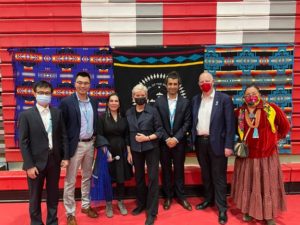
In the Kayenta Chapter of the Navajo Nation in Arizona, there are 24 households that have never enjoyed stable electrical power or an internet connection. A team of University of Utah engineering and architecture faculty, along with the Kayenta Chapter of the Navajo Nation, will be working to change that.
The team of U researchers and chapter leaders have received part of a two-year, $1.2 million grant from the U.S. Department of Energy to build an electrical microgrid and Wi-Fi connectivity for the Comb Ridge/El Capitan community in Kayenta, near the Utah border. On April 14, U.S. Department of Energy Secretary Jennifer Granholm and Arizona Congressman Tom O’Halleran traveled to Kayenta to meet with Navajo Nation leaders and U researchers and discuss the project. They also visited three of the homes that will be powered by this project, which will begin this summer.
The U team includes electrical and computer engineering assistant professors Mostafa Sahraei-Ardakani and Mingxi Liu, civil and environmental engineering assistant professor Jianli Chen and School of Architecture associate professor Shundana Yusaf.
The team will deploy 14 3.5-kilowatt BoxPower MiniBox and four 11-kilowatt and 18-kilowatt SolarContainers, portable solar-powered integrated energy systems to power the homes. This microgrid will also be monitored and controlled using a New Sun Road Stella operating system and a University of Utah-developed control algorithm. The broadband internet access will be enabled via satellite. The project will also create five trained jobs, six temporary jobs and three long-term jobs for the Diné people. The first year of the project is dedicated to microgrid design and installation, while the second year will be spent on testing and verification.
Because this microgrid utilizes a hybrid centralized and decentralized design with modular components, it is scalable to other native communities. It will provide an uninterrupted power supply to the community yet requires minimum maintenance cost and will have a minimal environmental footprint. And by providing full Wi-Fi connectivity to the people, that will enable online education, remote health care, and increased security.
“This project will fundamentally change this community’s power generation and usage pattern from coal-based generation to 100% solar power, from relying on external maintenance to 100% self-sustaining,” Liu said.
The future goal of the project is to research why similar communities lag behind the rest of the country in infrastructure and how these areas can overcome those barriers. The team also wants to create other pilot projects like the one in Kayenta and then adopt larger-scale solutions around the country. They also want to train members of similar communities to build, operate and maintain these kinds of power grids on their own.
“This project will have multiple impacts,” Sahraei-Ardakani said. “It will use our commercialized products to build a resilient, sustainable, and clean microgrid to electrify a community that is thirsty for power for years. It will create a first-of-its-kind pilot site that academic researchers can leverage to collect power generation and usage data in remote areas, as well as test advanced microgrid control approaches. More importantly, this project will largely boost the local economy by the jobs it creates and help preserve the native culture through its capacity-building programs.”